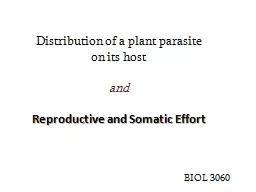

on its host and Reproductive and Somatic Effort BIOL 3060 Distribution of a plant parasite on its host gall distribution on the flowering dogwood Cornus florida Flowering dogwood ID: 292574
Download Presentation The PPT/PDF document "Distribution of a plant parasite" is the property of its rightful owner. Permission is granted to download and print the materials on this web site for personal, non-commercial use only, and to display it on your personal computer provided you do not modify the materials and that you retain all copyright notices contained in the materials. By downloading content from our website, you accept the terms of this agreement.
Slide1
Distribution of a plant parasite on its host andReproductive and Somatic Effort
BIOL
3060Slide2
Distribution of a plant parasite on its host: gall distribution on the flowering dogwood, Cornus floridaSlide3
Flowering dogwood, Cornus floridaSlide4
Midge fly, Resseliella clavulaSlide5
PurposeTo determine the distribution of midge galls on dogwood trees and to investigate some environmental factors that might influence distribution.Questions1) How are the galls distributed spatially?Random vs. clumped vs. uniform2) Could # or distribution of galls be related to:Size/age of the plant? Nearest neighbor distance? Sunny versus shady microhabitat?Slide6
P1: Random DistributionParasites are randomly distributed within the environment. If midges flew until they “hit” a dogwood haphazardly …402020
30
30
20
20
20
10
20
30
40
30
20
20
30
30
30
20
20
40
40Slide7
P2: Even Distribution“Regular”: Organisms are evenly spaced in the environment. In our case, every tree would have the same number of galls. This would suggest that the parasites are competing for the trees.1010
10
10
10
10
10
10
10
10
10
10
10
10
10Slide8
P3: Clumped DistributionMost trees have few parasites, and some a lot.Typically associated with:disease outbreakstree densities (“contagious”)age-related effects
0
30
30
30
30
0
0
0
0
0
0
0
0
0
0
0
0
0
0
30Slide9
Tree sizeOlder and infirm trees might be more likely to be attacked by the midge parasite.Distance to nearest neighborIf trees are close together, they might be more likely to attract galls.Collect gall data in two habitatsSome microhabitats might be better for galls than others. Environmental Factors We are MeasuringSlide10
Dogwood Identification (Winter)Flower buds(reproductive)Leaf bud(somatic)BothSlide11
Bark: dark brown with squarish, scaly blocks.Young trees will be smooth and not as distinctive. Slide12
Terminal BudsExamples of different numbers of bud scales Dogwood with two bud scales. Twigs are slender, green or purple.Slide13
Leaf ScarsDogwood leaf scars are opposite, small, and encircle twig. Example of alternate leaf scars Opposite leaf scarsTerminal budSlide14
Dogwood IdentificationFlowers: white, four petals (spring)Fruit: bright red, in clusters (late summer, fall)Leaves: opposite, veins curved